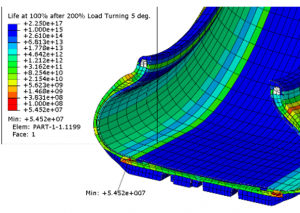Endurica targets elastomer-based ‘digital twin’ apps
The simulation tool can model the development of damage in elastomeric parts operating under realistic service conditions, said Findlay-based Endurica, which claims to have developed the world’s first ‘numerical fatigue life solver’ for elastomers.
The product can be used for computing damage from a schedule or histogram with multiple load cases and processing of finite-element fatigue analyses, the Ohio company added.
Users, it noted, can also stop and restart an analysis with incremental load history updates to obtain residual life and virtual damage state for Digital Twin applications.
“With this update, computing damage from a set of scheduled load cases now enables tire developers to simulate the FMVSS 119 / 139 tire durability and high speed regulatory standards,” said Endurica.
Residual life following tire-damage scenarios (overload, pothole, cleat impact, curbing, etc.) can also be readily computed, continued the statement.
Applications in the automotive component sector also include enabling developers concerned with checking part durability against block cycle testing specifications to simulate such tests through version 2.6 of Endurica CL.
The capability to stop and restart an analysis is aimed at ‘digital twin’ applications involving elastomer components where loading history is recorded on a periodic basis, and is used to generate diagnostics and analytics for continuous monitoring of structural health.
“Our fatigue analysis software provides powerful options to companies that develop elastomer components with a durability requirement,” said Dr. Wil Mars, Endurica LLC founder.
“Now you can quickly and inexpensively understand how your part’s durability in service is going to be impacted by your team’s design decisions,” he added.
The new features in version 2.6 [provide] added usability and diagnostic power. The new features also open the door to further applications, most notably in tires and digital twin applications.”
This article is only available to subscribers - subscribe today
Subscribe for unlimited access. A subscription to European Rubber Journal includes:
- Every issue of European Rubber Journal (6 issues) including Special Reports & Maps.
- Unlimited access to ERJ articles online
- Daily email newsletter – the latest news direct to your inbox
- Access to the ERJ online archive






